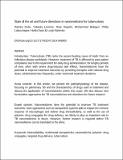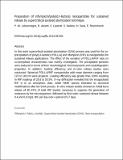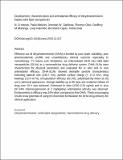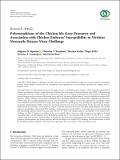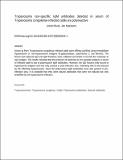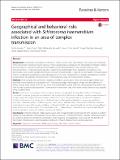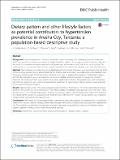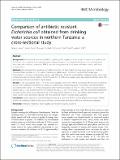Research Articles [LISBE]: Recent submissions
Now showing items 741-760 of 886
-
State of the art and future directions in nanomedicine for tuberculosis.
(Expert Opinion on Drug Delivery, 2013-12-01)Introduction: Tuberculosis (TB) ranks the second leading cause of death from an infectious disease worldwide. However, treatment of TB is affected by poor patient compliance due to the requirement for daily drug administration, ... -
The water uptake of poly(tetrahydrofurfuryl methacrylate)
(Elsevier, 1999-03)Poly(tetrahydrofurfuryl methacrylate) possesses some unique characteristics with respect to its biocompatibility and behaviour in water. The water uptake is high (>70%) and very slow (over 3 yr), but the material remains ... -
Preparation of rifampicin/lactose microparticle composites by a supercritical antisolvent-drug excipient mixing technique for inhalation delivery
(Elsevier, 2013-02)Rifampicin (RIF) is precipitated in the presence of inhalable lactose particles using a supercritical antisolvent-drug excipient mixing (SAS-DEM) technique to create RIF/lactose microparticle composites intended to improve ... -
Preparation of rifampicin/poly(d,l-lactice) nanoparticles for sustained release by supercritical assisted atomization technique
(Elsevier, 2014-11)In this work supercritical assisted atomization (SAA) process was used for the co-precipitation of poly(d,l-lactide) (PDLLA) and rifampicin (RIF) as nanoparticles for sustained release applications. The effect of the ... -
Development, characterization and antimalarial efficacy of dihydroartemisinin loaded solid lipid nanoparticles.
(Elsevier, 2016-04-01)Effective use of dihydroartemisinin (DHA) is limited by poor water-solubility, poor pharmacokinetic profile and unsatisfactory clinical outcome especially in monotherapy. To reduce such limitations, we reformulated DHA ... -
In vivo/in vitro pharmacokinetic and pharmacodynamic study of spray-dried poly-(dl-lactic-co-glycolic) acid nanoparticles encapsulating rifampicin and isoniazid.
(Elsevier B.V., 2013-02-28)Poly-(dl-lactic-co-glycolic) acid (PLGA) nanoparticles were prepared by a double emulsion solvent evaporation spray-drying technique and coated with polyethylene glycol (PEG 1% v/v). The PLGA nanoparticles had a small size ... -
Nanomedicine: Past, present and future - A global perspective.
(Elsevier Inc, 2015-12-18)Nanomedicine is an emerging and rapidly evolving field and includes the use of nanoparticles for diagnosis and therapy of a variety of diseases, as well as in regenerative medicine. In this mini-review, leaders in the field ... -
A review of the biology and detection methods of Cryptosporidium and Giardia spp in water sources and situation in Tanzania
(World Journal of Water Resource and Environmental Science, 2014-04)Cryptosporidium and Giardia species are the two most common enteric protozoan pathogens which affect humans worldwide. In both developed and developing countries. In immunocompetent individuals they cause self limiting ... -
Polymorphisms of the Chicken Mx Gene Promoter and Association with Chicken Embryos’ Susceptibility to Virulent Newcastle Disease Virus Challenge
(Hindawi, 2019-10-03)Newcastle disease is a devastating viral disease of chicken in low- and middle-income countries where the backyard production system is predominant. Marker-assisted selection of chickens that are resistant to Newcastle ... -
Molecular marker of Plasmodium falciparum resistance to chloroquine (Pfcrt) in an area with long history of antimalarial resistance
(American Journal of Research Communication, 2014)Background High levels Plasmodium falciparum resistance to Chloroquine (CQ) compelled Tanzania to replace CQ with Suphadoxine-pyrimethamine (SP) as first-line antimalarial in 2001 which was however replaced with Artemether ... -
Trypanosome non-specific IgM antibodies detected in serum of Trypanosoma congolense-infected cattle are polyreactive
(Elsevier Science, 1999-07-01)Serum Ig from Trypanosoma congolense-infected cattle were affinity-purified using immobilised trypanosome or non-trypanosome antigens (ß-galactosidase, cytochrome C and ferritin). The bound and unbound IgG and IgM fractions ... -
Rise in erythropoietin concentrations in experimental Trypanosoma congolense infection of calves
(Elsevier Ltd, 1995-11)A bioassay was used to measure erythropoietin (EPO) concentrations in calves with haemorrhagic anaemia due to blood loss and in calves with anaemia due to Trypanosoma congolense infection. The bioactivity of EPO was measured ... -
Modeling the proteome of a Marek's disease transformed cell line: a natural animal model for CD30 overexpressing lymphomas.
(Proteomics, 2007-04-18)Marek's disease (MD) in the chicken, caused by the highly infectious MD alpha-herpesvirus (MDV), is both commercially important and a unique, naturally occurring model for human T-cell lymphomas overexpressing the Hodgkin's ... -
Prevalence and predictors of oral thrush among Maasai in Ngorongoro Conservation Area: A preliminary consideration
(iMedPub, 2014)Background: It was reported by clinicians working in the Ngorongoro Conservation Area that about 40% of Maasai pregnant women reporting at the Antenatal Clinic were diagnosed with oral thrush. However, it was not ... -
Challenges in Diagnosis of Febrile illnesses in Tanzania in the Era of Declining Malaria Epidemiology
(American Journal of Research Communication, 2015)Malaria and other febrile illnesses are very common especially in children in developing countries. Due to reliance on clinical algorithms for diagnosis in resource-poor settings, most febrile episodes have always been ... -
Geographical and behavioral risks associated with Schistosoma haematobium infection in an area of complex transmission
(Parasites & Vectors, 2018)Background: Schistosoma haematobium infection in endemic areas varies depending on the nature and complexity of the transmission networks present. Studies of micro-geographical transmission of S. haematobium infection ... -
Monitoring of efficacy and safety of artemisininbased anti-malarials for treatment of uncomplicated malaria: a review of evidence of implementation of anti-malarial therapeutic efficacy trials in Tanzania
(BioMed Central, 2015)Background: Prompt diagnosis and effective treatment are considered the cornerstones of malaria control and artemisinin-based combination therapy (ACT) is currently the main anti-malarial drugs used for case management. After ... -
Dietary pattern and other lifestyle factors as potential contributors to hypertension prevalence in Arusha City, Tanzania: a population-based descriptive study
(BMC Public Health, 2017)Background: High blood pressure is increasing worldwide, disproportionately so in developing countries. Inadequate health care systems and adoption of unhealthy lifestyles have been linked to this emergent pattern. To ... -
Comparison of antibiotic resistant Escherichia coli obtained from drinking water sources in northern Tanzania: a cross-sectional study
(BMC Microbiology, 2016)Background: Antimicrobial resistance (AMR) is a growing and significant threat to public health on a global scale. Escherichia coli comprises Gram-negative, fecal-borne pathogenic and commensal bacteria that are ... -
Differences in Hypertension Risk Factors between Rural Maasai in Ngorongoro and Urban Maasai in Arusha Municipal: A Descriptive Study
(Journal of Applied Life Sciences International, 2014-08-08)Background: Many ethnic groups within Tanzania are migrating from rural to urban areas in search of jobs and better livelihoods. One such group is the Maasai, whose distinct ethnicity and lifestyle potentially offers ...

